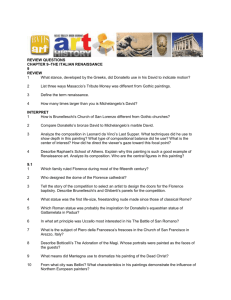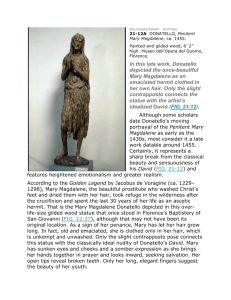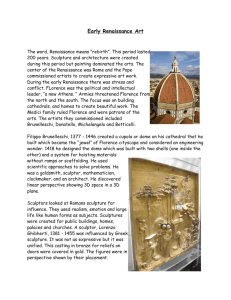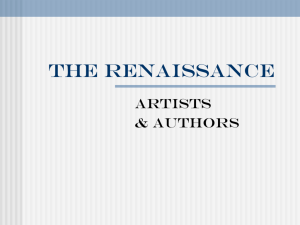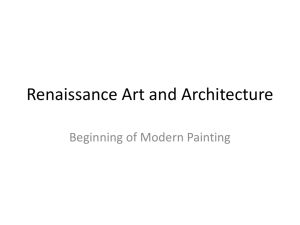Slideshow - Resources
advertisement
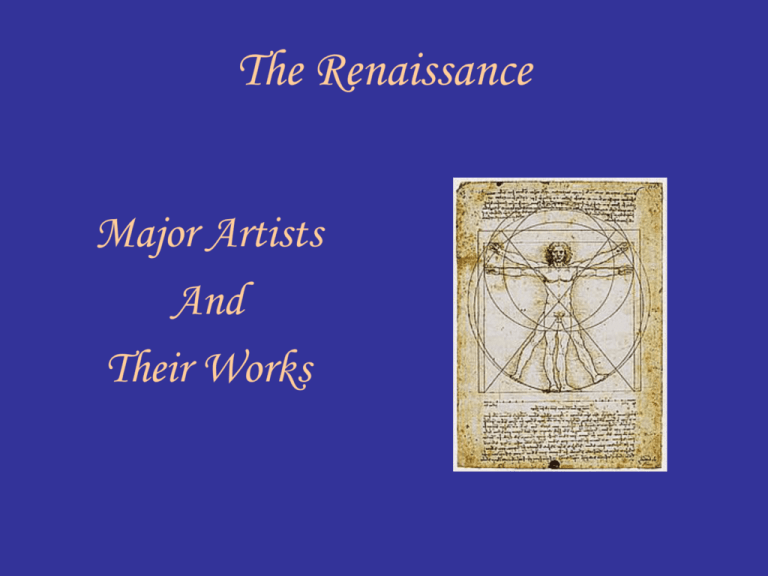
The Renaissance Major Artists And Their Works The Top Four Breakthroughs of Renaissance Art • Oil on Stretched Canvas • Perspective – illusion of depth on a flat surface • Use of Light and Shadow • Pyramid configuration – the focal point is at the center of the picture. Masaccio • First since Giotto to paint human form not as a linear column but as a real human being. • “Masaccio made his figures stand upon their feet.” – Vasari • Mastery of perspective and the use of a single constant source of light casting accurate shadows. Adam and Eve Expulsion from the Garden of Eden Jesus and the 12 Apostles Donatello • His work recaptured the central discovery of Classical sculpture: contrapposto, or weight concentrated on one leg with the rest of the body relaxed, often turned. • Focused on skeletal structure. David • First life size, freestanding nude sculpture since classical period. • Heroic nudity • Bronze sculpture Mary Magdalene • Carved as gaunt, shriveled hag, with stringy hair and hollowed eyes. • So life like Donatello was said to have shouted at it,”Speak, speak, or the plague take you!” St. John Botticelli • Linear style • Tiptoed golden-haired maidens, throw back to Byzantine art. • Nudes epitomized the Renaissance Birth Of Venus • Marks Rebirth of Classical Mythology • Undulating lines and figures with long necks, sloping shoulders, and pale soft bodies. The Annunciation Dante’s Hell Mystical Nativity Leonardo Da Vinci • True Renaissance Man • Mathematician, scientist, artist • Stressed the Intellectual aspect of art and creativity • Transformed artist’s public status into, “Lord and God.” • On his deathbed he confessed, “I have offended God and mankind by not working at my art as I should have.” “I wish to work miracles.” The Last Supper Fresco pre-repair Notebooks Evidence of Leonardo’s fertile imagination lies in the thousands of pages of sketches and ideas in his notebooks. Although his notes were unknown to later scientists, he anticipated many of the discoveries and inventions of succeeding centuries. His sketches of the growth of the fetus in the womb were so accurate they could teach embyrology to medical students today. Leda and the Swan Sketch Mona Lisa • The portrait set the standard for High Renaissance paintings. • The use of the pyramid perspective. • Triangular composition. • Displays subject as relaxed and natural, three quarters pose. • Use of smile. • Most reproduced image in art. Michelangelo • Grew up absorbed with carving and drawing. • At age 15, taken by Medici family to live in Florence and live like a son. • Alone in solitude, effected attitude. Emotional, rough, and uncouth, would not let anyone watch him work. • Architect, sculptor, painter, poet, and engineer. • “I regret that I am dying just as I am beginning to learn the alphabet of my profession. La Pieta • First Masterpiece • Groups Mary and Jesus in Traditional Triangle/Pyramid composition. • Classic composure of the Virgin’s face reflects the calm idealized expression of Greek sculpture. • When first unveiled, a viewer attributed the work to a more experienced sculptor, unable to believe a young 22 year old unknown could accomplish such a triumph. When he heard, he went into the Vatican and carved his name on a ribbon across Mary’s breast, the only work he ever signed. The Sistine Chapel Ceiling • 340 human figures • Represents the origin and fall of man. • Took less than four years. • 10,000 square feet • Figure painting from imagination, torsos more expressive than the faces. Sistine Chapel Alter Piece The Last Judgment • Finished 29 years after ceiling. • Depicts Christ not as merciful redeemer but as avenging judge. • 400 hundred contorted figures struggle, fight, and tumble to hell. David • Heroic Nudity. • Over proportioned hands, head, and feat. • Relaxed pose in movement. • Compare to Donatello’s David. Moses • Designed for tomb in Vatican • Has horns. • Massive scale. Tombs of the Medici The Designer • Designed the Swiss Guard Uniform Raphael • • • • • Outgoing Learned painting from father. Master at age 17. Used Pyramidal composition. Modeled faces with light and shadow. • Adapted full bodied dynamic figures and the contrapposto pose. School of Athens • Balance • Sculptural quality • Architectural perspective • Fusion of Pagan and Christian elements. The Three Graces Cherubs The Last Judgment • Compare to Michelangelo’s the Last Judgment. Titian • Father of modern painting. • Dominated art in Venice for 60 years • Use of strong colors as main device of expression • Established oil on canvas as typical medium Venus of Urbino John the Baptist Mary Magdalene St. Jerome Cain and Abel Adam and Eve • Multiple revisions • Notice the serpent Jan Van Eyck • Credited with inventing oil painting • After his death, right arm preserved as a holy relic • Focused on extreme details Arnolfini Wedding • Captures surface appearance and textures precisely and renders effects both direct and diffused light. Up-Close • A master of realism, Van Eyck recreates the marriage in miniature in the mirror. • Virtually every object symbolizes the painting’s themes – the sanctity of marriage – with the dog representing fidelity and the cast off shoes holy ground. Adam and Eve St. Christopher The Virgin with Child Hieronymous Bosch • Moralistic paintings suggested inventive torments meted out as punishments for sinners. • Grotesque fantasy images – inhabited his weird, unsettling landscapes. • He believed that corrupt mankind, seduced by evil, should suffer calamitous consequences. The Garden of Earthly Delights • An allegory, warning against the dangers of eroticism. Forerunner of surrealism Up-close Ship of Fools Untitled Hans Holbein • German born – left for England during Reformation • Portrait painter • Linear patterning • Accurate textures • Symbolic knickknacks • Neutral faces St. Thomas More Erasmus The Ambassadors Albrecht Durer • Believed art should be based on scientific observation. • Called “Leonardo of the North.” • Gentleman scholar – raised artist stature from craftsman to near prince. • Worked in woodcuts and graphic techniques The Madonna and Child The Fallen Angels The Four Horseman of the Apocalypse Melencolia Knight Death and the Devil St. Jerome El Greco • Use of inner light of in forms. • Harsh colors • Distorted figures • Elongated figures • Cared little for accurately representing the visual world. • Preferred to create an emotion laden vision of celestial ecstasty. Agony in the Garden Loacoon Candle Light Mary Magdalene Caravaggio • Most original painter of 17th Century • Painted bodies in “down and dirty” style • Secularized religious art making saints and miracles seem like ordinary people and everyday events. Calling of St. Matthew • Apostle to be sits in the pub surrounded by dandies counting money when ordered to “Follow” Christ. A strong diagonal beam of light illuminates the thunderstruck tax-collector’s expression and gesture of astonishment. Conversion of St. Paul • Shows Paul flat on his back, fallen from his horse, which is portrayed in an explicit rear end view. • The hard focus and blinding spotlight reveal details like veins on the attendant’s legs and rivets on Saul’s armor, while inessential elements disappear in the dark background. St. John the Baptist St. Peter’s Crucifixion Salome David and Goliath St. Thomas The Annotated Mona Lisa: A Crash Course in Art History From Prehistoric to PostModern • Carol Strickland, PhD. • 1992, Adrews and McMeel, Universal Press. • Kansas City, Missouri. • Most ideas about art in this slideshow are a product of this text and the author’s real life experience of the art objects.


